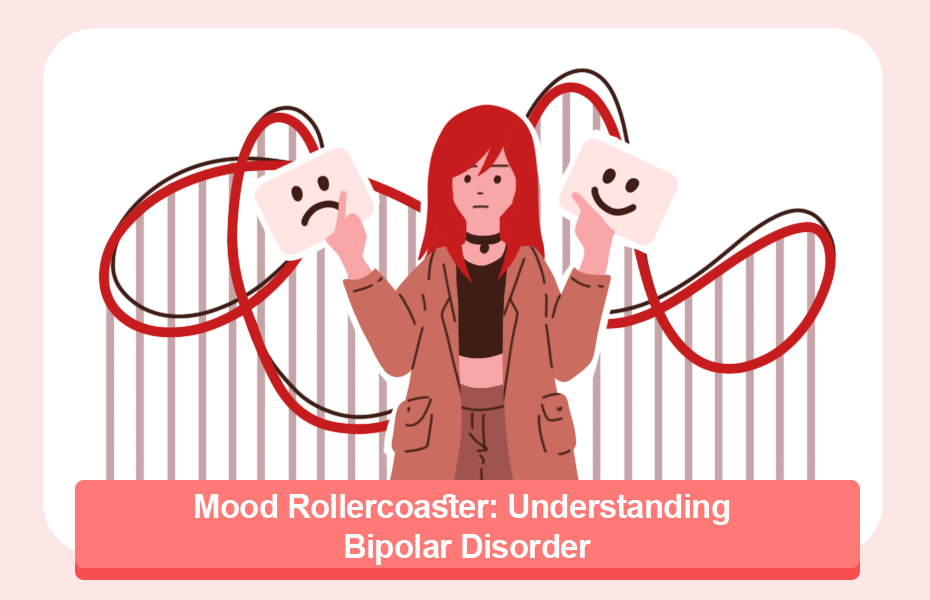Mood Rollercoaster: Understanding Bipolar Disorder
Understanding bipolar disorder and its symptoms is the first step in improving. Most medical professionals can point you in the right direction if you feel you may suffer from bipolar disorder. It may also involve speaking to family or friends, to determine if there are other genetic mental problems within the family and see what loved ones have observed about you.
Physical conditions are often easy to spot, and even easy to treat. Unfortunately, mental conditions are often not as simple, in part because they are difficult to recognize. Below we explain the condition of bipolar disorder, how to spot it, and what to do if you or a loved one may have it.
What Is Bipolar Disorder?
The definition of bipolar disorder is a mental/psychotic condition, in which people go from depressive moods to elated (sometimes called manic) phases. It is not a disease or illness, but a mood disorder. These feelings are extreme, not moderate.
Bipolar disorder is also not simply a part of one’s personality or their natural characteristics. While the causes are not completely known, bipolar disorder likely stems from both genetic and environmental factors.
People experience bipolar disorder in very different ways, sometimes with major symptoms and sometimes mild. Some may experience more depressive or more manic episodes. Often, people who suffer from bipolar disorder also have other conditions, such as anxiety disorder, ADHD, and multiple personality disorder that impact them. It usually occurs in about 1%-3% of the population.
Normal Feelings vs Bipolar Disorder
Common feelings and even depression can often be mixed up with bipolar disorder. Feeling sad or happy in cycles is often natural. Feeling different depending on the season can also be natural, or linked to seasonal depression. The key difference is that bipolar is chronic; it’s not just feeling sad or happy sometimes as a phase or rapid cycling of emotions.
Many wonders when do symptoms of BD appear. The symptoms of bipolar disorder can appear at any age but usually appear around the mid-20s. In males, this is usually the average, though it can appear at any age. In females, the age is also similar. It’s important to note that postpartum depression is not a trigger or sign of bipolar disorder.
| Normal | Mood changes with season | Months-long mood shifts | Occasional sadness or hyperactivity | Sleep issues |
| Bi-Polar | X | X | X | X |
Types of BD
There are two main types of bipolar disorder. Type 1 is classified by longer periods of depressive episodes. Type 2 is classified by more periods of manic episodes.
Symptoms of Bipolar Disorder in Adults
So what are the symptoms and signs? The top 10 symptoms include in men and women:
- persistent feelings of sadness;
- irritability;
- loss of interest in things you usually enjoy;
- short attention span;
- racing thoughts;
- risky tendencies (like hypersexuality, spending money, doing other possibly harmful activities);
- agitation/anger;
- inability to sleep properly;
- substance abuse;
- change in appetite.
Bipolar disorder can be triggered by things such as stress, relationship issues, and anxiety related to many aspects of adult life. This is why bipolar disorder often makes itself evident in the mid-20s. People experience bipolar disorder in different ways, so if you feel you may have more than a few of these symptoms on the list, even if not all, it is a good idea to seek help.
What Is Manic Episode Symptoms?
A manic episode is one in which a person feels a sense of hyperactivity and euphoria. This does not just mean feeling happy, but being abnormally elated. Symptoms of a manic episode include:
- short attention span;
- talking quickly;
- racing thoughts;
- risky tendencies (like hypersexuality, spending money, doing other possibly harmful activities);
- agitation;
- inability to sleep properly;
- substance abuse;
- change in appetite.
Generally, manic episodes are classified as such when they impair a person’s ability to function, are atypical, and tend to last 3-6 months. Simply having one or two of these symptoms may not be a sign of bipolar disorder. It is normal to have certain times in which you are more happy and hyperactive, but these moods should not interfere with your ability to go about your daily life. Bipolar disorder also often leads to social isolation and can hurt relationships in cases where the sufferer cannot control their actions or temper and be around people.
Signs of Depressive Episode
Depressive episodes have very similar symptoms to depression, though they are different in that they are a part of a mixed state. These include:
- persistent feelings of sadness;
- irritability;
- loss of interest in things you usually enjoy;
- short attention span;
- racing thoughts;
- risky tendencies (like hypersexuality, spending money, doing other possibly harmful activities);
- agitation/anger;
- inability to sleep properly;
- substance abuse;
- change in appetite.
These episodes tend to last at least two weeks. Often, these symptoms are mistaken for the person suffering from only depression. It is important to look out for manic episodes as well, in order to determine that the condition is bipolar disorder and not just depression.
What Is a Hypomanic Episode?
Hypomania is another aspect of bipolar disorder. Hypomanic episodes are a sort of toned down version of manic episodes and don’t always occur. These tend to last for a few days to a week, and while they have many similar symptoms of a manic episode, they do not as severely impact a person’s life.
Is Compulsive Lying a Symptom of BD?
Compulsive lying is not a definite symptom of bipolar disorder. Though this is a preconceived idea that many have, there is nothing to prove that bipolar disorder adds to compulsive lying. However, some of the common symptoms associated with bipolar disorder can make compulsive lying – though unintentionally – more common in people who suffer from it. Impaired judgment, unnaturally elated feelings and self-regard, and racing thoughts, which are common in manic episodes, can cause people to stretch the truth.
Are Hearing Voices and Paranoia the Symptoms?
Hearing voices and paranoia are not proven symptoms of bipolar disorder. However, many people who suffer from bipolar disorder also suffer these symptoms. Both hearing voices and paranoia are commonly classified as symptoms of schizophrenia syndrome. Sometimes, in manic episodes, it is possible for sufferers of bipolar disorder to hear or see things that are not there, also known as having delusions. The difference between this and schizophrenia is that those with bipolar disorder only experience these symptoms during manic episodes, not on a regular basis.
Symptoms of Bipolar Disorder in Children and Teens
Bipolar disorder can have an early onset. Because children are often not good at communicating their feelings and thoughts, it may be more difficult to know if they are suffering from bipolar disorder. There are however some symptoms you may observe in your child that could be signs of bipolar disorder:
- short temper;
- hyperactivity;
- have unusual sleep patterns;
- changes in appetite;
- feel very sad or very happy.
In children, manic and depressive episodes may be more difficult to distinguish between as well. A pediatric doctor can point you in the right direction if your child is experiencing these symptoms.
Teens may also have difficulty understanding if they are dealing with bipolar disorder because they experience mood swings as a natural part of puberty. They may experience many of the same symptoms as children. Additionally, they may be more inclined toward substance abuse, interest in sex, and risky behavior as a way of dealing with their condition. While teenage years can be difficult for a number of reasons, bipolar disorder often gets worse with age. Thus, if symptoms are only increasing after the teenage years, it may be a sign of bipolar disorder and not just mood swings.
How it affects family is also a key component in treating and dealing with bipolar disorder in children and teens. The effects on the family and advice for families revolves around ensuring children are supported. Living in instability can worsen symptoms for children while showing love can alleviate them.
Stereotypes of Bipolar Disorder
There are many classic, harmful stereotypes about people with bipolar disorder. These includes things such as people who suffer are violent and unpredictable. While this is sometimes the case, these angry and violent tendencies are not always a result of bipolar disorder.
Many people assume bipolar disorder is about having constant moods swings and always feeling either elated or depressed. Rather, the swings in mood that those with bipolar suffer from are not as constant or volatile as hormonal mood swings – like the ones women may experience when on their period during ultradian rhythms. These changes in mood tend to last a longer time (up to months). Those with bipolar disorder also may not be in a manic or depressive episode at all times or experience both of these equally. A person may be in a manic episode for many months and rarely depressed, or the other way around.
How to Help Someone with Bipolar Disorder?
Loving someone with BD can be very difficult, but understanding and helping your partner/friend/family member is the first step to resolving many of the issues associated with it. The best way to help someone with bipolar disorder is to encourage them to seek help. A friend or family member can be a great opportunity for the person to talk about how they feel and explore options.
It’s best not to tell the person that what they are feeling is illegitimate, may or may not be bipolar disorder, or force them to seek help. Instead, one of the best ways to help is to give them resources they need to seek help and assure them that you will be there for support should they want it.
Where Can I Get Help?
Many people who think they may have bipolar disorder wonder “how do I get help?”
Understanding bipolar disorder and its symptoms is the first step in improving. Most medical professionals can point you in the right direction if you feel you may suffer from bipolar disorder. Diagnosing is done by asking the person a number of questions about their habits, feelings, and so on. Usually this is done by a trained psychiatrist. It may also involve speaking to family or friends, to determine if there are other genetic mental problems within the family and see what loved ones have observed about you.
In some cases, there may be physical tests (like blood work) to determine that symptoms are not caused by a physical condition. The most effective treatments are counseling and medication, and help groups are also a great way of getting support.















